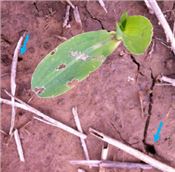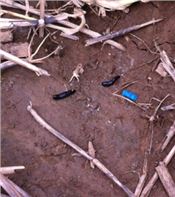|
Moist Soils May Cause Outbreaks Of Slugs In Late-Season Soybean Planting
DR. RAUL T. VILLANUEVA
PRINCETON, KY.
Slugs are not insects, thus insecticides to control bugs are not effective to control this pest. Slugs are mollusks and related to snails. This year, during late April and early May, I received information on the presence of slugs causing damage to corn seedlings in Daviess and Fayette Counties (Figure 1). Now, this time in early August, it seems that slug numbers are increasing and feeding on late-planted small soybean plants.
There are several species of native and invasive slugs in Kentucky (A Field Guide to the Slugs of Kentucky). Native slugs are important to balance the ecosystem, feeding on plants, lichen or fungi in wooded areas; while invasive species may severely affect wheat, corn, soybeans, vegetables, or ornamental plants.
Slug Habitats and Damage
Slugs prefer cool, moist habitats and can be founds under logs, rocks or under pots. The environmental conditions of 2016, with continuous rains and wet soils, favor population outbreaks of slugs. This condition increases when planting is conducted on no tillage fields. Under this situation, slugs move deep into the ground during the day and become very active from sunset to sunrise. During this time slugs rasp leaf surfaces, may produce scars or holes on plants overnight, or kill completely small seedlings.
Soybeans are resilient plants, and they may recover if there is partial feeding on leaves or stems were not completely damaged. However, if the two cotyledons are eaten, this may result in reduced planting density or produce empty spots in rows.
Management
I was informed that in corn, there are some who make applications of muriate or potash salts; however, there are no data showing the benefits of these applications.
My personal experience with slugs involves a farmer who made an application of Metaldehyde bait (e.g., Deadline products) in corn at a rate of 10 lb/A. Large numbers of dead slugs were observed 1 day after pellets had been applied in this field (Figure 2). Unfortunately, tallies of slugs were not conducted before or after the application.
Cultural practices that aid in avoiding slug damage should be considered during soybean planting and soil cultivation. During planting, rows should be straight and 1 to 1.5 inches deep, but no deeper than 2 inches to avoid delay of soybean germination and reduce the opportunity of snail feeding. During cultivation the hatch should not cover adjacent rows, so small plants or seedlings are not under this substrate.
Corn Earworms in Late Soybean Plantings
Finally, I want to acknowledge a recommendation from my predecessor, Dr. Doug Johnson, about late soybean plantings. He thinks that due to planting delays experienced by rain in 2016, the presence of corn earworms might significantly affect soybean pods. Corn earworm will feed primarily on the developing pods of soybean planted late. Farmers and consultants may need to contemplate this during scouting for pests. ∆
DR. RAUL T. VILLANUEVA: Extension Entomologist, Princeton, KY.

Figure 1. Damage caused by slugs in corn during late April 2016 in Daviess County.
During the day, slugs move deep into the ground through gaps or holes (indicated by arrows);
and then they become active during the night, causing this type of damage on crops.
Photos: Raul Villanueva, UK

Slug dead & pellet Fig 2
|
|